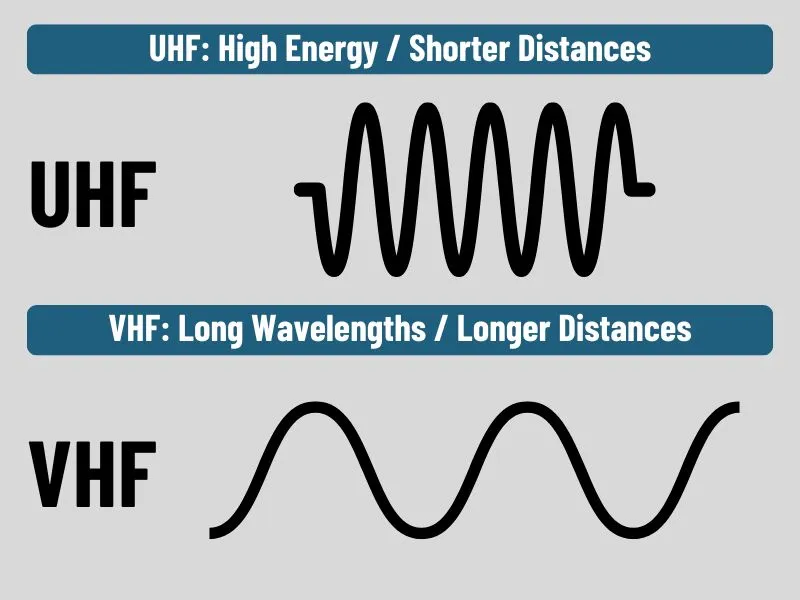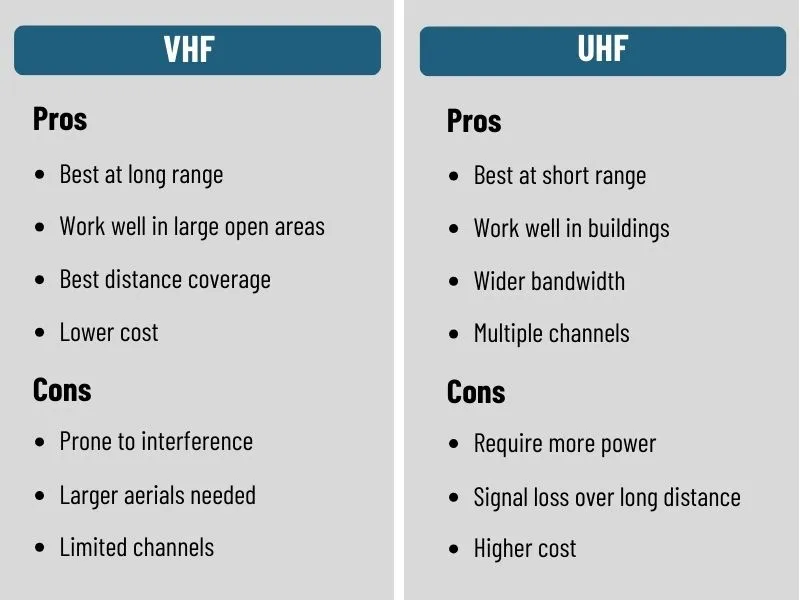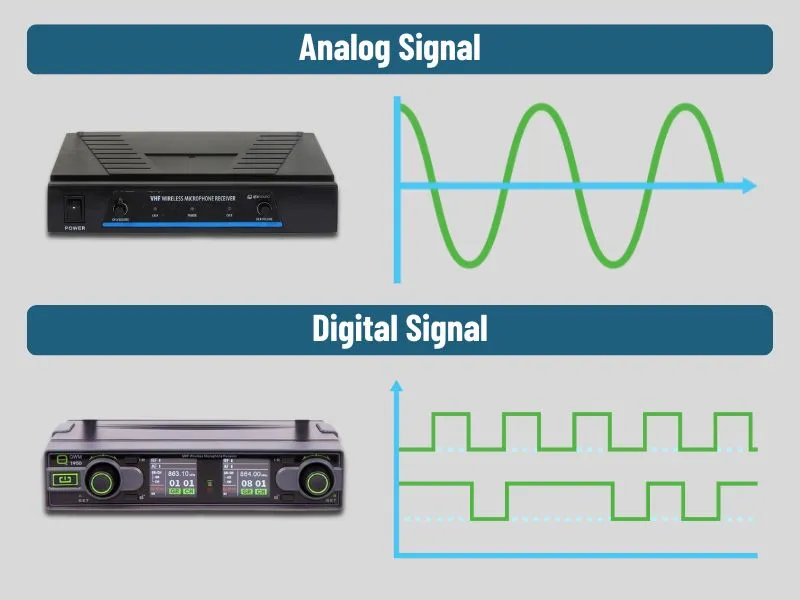UHF or VHF for Wireless Microphones
UHF vs VHF
The world of wireless microphones can be quite the labyrinth of acronyms and technical jargon, particularly when confronted with choices like UHF (Ultra High Frequency) and VHF (Very High Frequency). Let's take a look at the technology, and the terminology, and hopefully shed some light on the differences, offering insight to both enthusiasts and the uninitiated.
Understanding the technical underpinnings and practical implications of selecting UHF or VHF microphones for different purposes allows you to make informed decisions tailored to your specific needs, whether it be for professional audio engineering, live performances, or casual use.
What is the difference between VHF and UHF?
At the core of the VHF and UHF delineation lies their respective positions on the electromagnetic spectrum. VHF operates within the 30 MHz to 300 MHz range, whereas UHF spans from 300 MHz to 3 GHz. This frequency allocation has profound implications for their performance characteristics and suitability for various applications.
VHF signals feature longer wavelengths and are better suited for outdoor use where the line of sight between the wireless microphones transmitter and receiver is unobstructed. They can traverse longer distances without significant loss of signal quality but are more susceptible to interference from other radio frequency sources. UHF, with its shorter wavelengths, excels in penetrating through dense materials like walls, making it the go-to choice for indoor environments where obstacles are commonplace.
The choice between VHF and UHF also impacts the number of available channels and bandwidth. UHF, by its higher frequency range, can accommodate a greater number of channels, allowing for more microphones to operate simultaneously without interference. This characteristic makes UHF microphones particularly valuable in settings where multiple mics are required, such as theatrical performances or large conferences.




Which is better VHF or UHF?
The question of whether VHF or UHF microphones are superior is not straightforward and hinges on the specific requirements of the user. UHF systems, with their ability to navigate through obstacles and support a higher number of simultaneous channels, are often favoured for professional settings where reliability and flexibility are paramount. Their higher frequency range allows for a clearer sound quality and less susceptibility to interference, making them ideal for indoor use and complex setups involving multiple microphones.
On the other hand, VHF microphones, while limited in channel availability and more prone to interference, offer a cost-effective solution for applications where these limitations are not deal-breakers. For outdoor events or situations where fewer microphones are needed, VHF can be an economical and practical choice. Furthermore, the longer range of VHF signals can be advantageous in open-air settings or when the microphone needs to be used at greater distances from the receiver.
Ultimately, the decision between VHF and UHF should be guided by factors such as the intended use environment (indoor vs outdoor), the number of microphones required, budget constraints, and the overall audio quality that's required.
Are VHF and UHF Analog or Digital?
UHF or VHF are simply the bands of frequencies being used for radio waves, which are a type of electromagnetic radiation that occurs naturally on Earth and through space. We tap into these specific frequencies and send signals between two or more points without the need for a physical connection. All electromagnetic fields and waves are classed as analog. The signal we send over these analog waves however can be either analog or digital, and this is decided by the transmission equipment.
Analog wireless microphones have been the standard for many years, transmitting audio signals through continuous waves that mirror the original sound. This technology is known for its reliability and simplicity but can be susceptible to interference and noise, potentially compromising sound quality.
Digital wireless systems, on the other hand, convert sound into digital data before transmission. This process allows for clearer audio, as digital signals are less prone to interference and can be encrypted for secure communication. Additionally, digital systems often feature greater dynamic range and frequency response, leading to superior sound quality. However, these benefits come at a cost, both literally and in terms of potential latency issues, as the conversion process can introduce a slight delay.


Read More...
Exploring Wireless Microphones
Wireless microphones have revolutionized the audio industry, offering unparalleled freedom and flexibility to performers, speakers, and audio professionals. At the heart of this revolution lies a choice between two primary bands: VHF and UHF. Understanding the technical nuances and operational contexts of these bands is crucial for making informed decisions that best meet one’s audio requirements.
The Electromagnetic Spectrum and Wireless Microphones
The electromagnetic spectrum is a vast expanse of frequencies, of which VHF and UHF are but a small part:
VHF, spanning from 30 MHz to 300 MHz, offers the benefit of longer wavelengths, which are less prone to attenuation (signal loss over distance) and can thus cover larger distances outdoors with less power. However, these frequencies are more likely to encounter interference from other sources, such as TV broadcasts or emergency services, due to the crowded nature of this spectrum segment.
UHF, with frequencies ranging from 300 MHz to 3 GHz, provides shorter wavelengths that are adept at navigating physical barriers, making UHF microphones the preferred choice in environments cluttered with obstacles, such as multi-room venues or urban areas. The higher frequency range of UHF also allows for a broader selection of channels, reducing the likelihood of interference between devices and enabling more microphones to operate concurrently. This feature is particularly valuable in settings requiring numerous microphones, such as musical productions, conferences, or broadcast studios.
Wireless Range
Most wireless microphone systems for entertainment use provide their specifications of maximum range to be around 100ft to 1000ft (30m to 300m). For a size reference, a football pitch is 360ft (110m).
It can seem a bit vague to consumers, but it has to be due to there being so many variables. Critical factors that influence range include the type of signal, the antenna design, environmental barriers (buildings, material types), and the transmitter's power output (measured in watts). No single element guarantees an extended range; however, when considered together, they can significantly impact your range.
Of all these, the main one limiting wireless mic range is their transmission power, which is below 10mW for them to remain license-free.
Technical Advantages of UHF over VHF
One of the primary technical advantages of UHF microphones is their superior bandwidth capability. Bandwidth, in this context, refers to the range of frequencies that a microphone system can use to transmit audio signals. A wider bandwidth means that the microphone can handle more information at once, leading to better sound quality and reduced chances of signal interference. Additionally, UHF systems are typically designed with more sophisticated circuitry and filtering options, further enhancing their ability to deliver clear, high-quality audio in diverse environments.
Another advantage of UHF systems is their scalability and flexibility. The ability to operate on a larger number of channels means that users can easily expand their setups to include more microphones as needed, without fear of cross-channel interference. This scalability makes UHF systems particularly attractive for venues or events that may need to accommodate various speakers or performers.
Consider a scenario where you're attempting to communicate across a commercial property, hindered by a metal wall with a three-foot gap. Metal is impenetrable by radio waves. Given that the UHF wavelength is about one and a half feet in size and the VHF wavelength spans approximately five feet, the UHF signal can easily traverse the gap, whereas the VHF signal is deflected due to its greater width. This illustrates UHF's superiority in navigating through the confined spaces of a building to reach its target, as VHF signals are more likely to be obstructed by the building's metal components.
The Case for VHF in Specific Scenarios
Despite the apparent dominance of UHF in professional settings, VHF microphones retain their relevance in specific scenarios. Their longer wavelength properties can be particularly advantageous for outdoor events where line-of-sight transmission is possible, and the risk of signal obstruction is minimal. VHF systems are also generally less expensive than their UHF counterparts, offering a budget-friendly option for users with less demanding requirements.
Imagine transmitting VHF and UHF waves across an open field; the VHF wave would reach nearly twice as far. This makes them a great option for sporting events and things like school sports days where they provide a good quality, low-cost option for announcements.
You might think, "VHF sounds perfect!" But hold on. Despite VHF's superior range, it isn't always the optimal choice. This is due to how VHF and UHF signals behave differently around buildings. It's crucial to note that UHF signals have a shorter wavelength compared to VHF, which is particularly relevant in urban environments.
Digital Evolution: Enhancing Wireless Microphone Technology
The advent of digital wireless microphone technology has introduced a new dimension to the debate between VHF and UHF. Digital systems, which can operate on either VHF or UHF frequencies, encode audio signals into digital data before transmission. This digital encoding process significantly reduces the susceptibility to interference and noise, ensuring that the audio quality remains high, even in environments crowded with competing signals. Additionally, digital systems often employ sophisticated compression algorithms to maximize audio fidelity and dynamic range, further distinguishing them from their analog counterparts.
Digital technology also introduces the possibility of enhanced features such as automatic frequency hopping, which allows the system to dynamically switch frequencies to avoid interference, and encrypted transmissions, which are vital for confidential communications. These advancements have made digital wireless systems increasingly popular among professionals who prioritize audio quality and reliability.
The Future of Wireless Microphone Technology
As we look to the future, the landscape of wireless microphone technology continues to evolve. These systems will not only deliver superior audio quality but also offer greater control and flexibility through remote monitoring and configuration.
Moreover, regulatory changes and the reallocation of frequency bands pose ongoing challenges and opportunities for wireless microphone technology. The ongoing shift towards digital broadcasting and mobile broadband services has led to a reevaluation of spectrum allocation, necessitating a more efficient use of available frequencies. In response, manufacturers are developing more spectrum-efficient technologies, such as cognitive radio, which can dynamically access underutilized frequencies without causing interference to existing users.
Conclusions
The choice between VHF and UHF microphones, and between analog and digital systems, hinges on a complex interplay of factors including environment, application, budget, and personal preference. While UHF and digital systems offer clear advantages in terms of flexibility, scalability, and audio quality, VHF and analog systems remain relevant for specific needs and contexts.
The general principle is that for outdoor use, where clear line-of-sight is available, VHF is preferable for its longer range capabilities. However, for indoor use, urban settings, or areas with dense vegetation, UHF is more effective at circumventing obstacles and avoiding potential "dead zones." The decision essentially boils down to prioritizing distance (VHF) versus the ability to avoid obstructions within and around buildings (UHF).
As technology continues to advance, the key for users is to stay informed about the latest developments and regulatory changes affecting wireless microphone systems. By doing so, they can select the most appropriate technology that meets their needs today while remaining adaptable to the audio landscapes of tomorrow.


